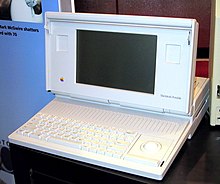1986–1993: Rise and fall
Having learned several painful lessons after introducing the bulky Macintosh Portable in 1989, Apple introduced the PowerBook in 1991, which established the modern form factor and ergonomic layout of the laptop computer.[45] The Macintosh Portable was designed to be just as powerful as a desktop Macintosh, but weighed 17 pounds with a 12-hour battery life. The same year, Apple introduced System 7, a major upgrade to the operating system, which added color to the interface and introduced new networking capabilities. It remained the architectural basis for Mac OS until 2001.
The success of the PowerBook and other products led to increasing revenue.[43] For some time, it appeared that Apple could do no wrong, introducing fresh new products and generating increasing profits in the process. The magazine MacAddict named the period between 1989 and 1991 as the "first golden age" of the Macintosh.
Following the success of the Macintosh LC, Apple introduced the Centris line, a low-end Quadra offering, and the ill-fated Performa line that was sold in several confusing configurations and software bundles to avoid competing with the various consumer outlets such as Sears, Price Club, and Wal-Mart, the primary dealers for these models. The result was disastrous for Apple as consumers did not understand the difference between models.[46]
During this time Apple experimented with a number of other failed consumer targeted products including digital cameras, portable CD audio players,speakers, video consoles, and TV appliances. Enormous resources were also invested in the problem-plagued Newton division based on John Sculley's unrealistic market forecasts.[citation needed] Ultimately, all of this proved too-little-too-late for Apple as their market share and stock prices continued to slide.[citation needed]
Apple saw the Apple II series as too expensive to produce, while taking away sales from the low end Macintosh.[47] In 1990, Apple released the Macintosh LC with a single expansion slot for the Apple IIe Card to migrate Apple II users to the Macintosh platform.[47] Apple stopped selling the Apple IIe in 1993.
Microsoft continued to gain market share with Windows, focusing on delivering software to cheap commodity personal computers while Apple was delivering a richly engineered, but expensive, experience.[48] Apple relied on high profit margins and never developed a clear response. Instead they sued Microsoft for using a graphical user interface similar to the Apple Lisa in Apple Computer, Inc. v. Microsoft Corporation.[49] The lawsuit dragged on for years before it was finally dismissed. At the same time, a series of major product flops and missed deadlines sullied Apple's reputation, and Sculley was replaced by Michael Spindler.[50]
